The Lowdown
My experience was a solid 3/5 (which isn’t bad!), but I’m going to give it 3.5/5. This is simply due to the fact that I KNOW Control Ultimate Edition will scratch an itch for enough people out there that their experience will be anywhere from 4-4.5 out of 5. Let’s just split the difference, shall we?
Overall
Pros
- Great world ambiance and design
- Telekinetic Launch Ability/Levitate are really fun
- Some missions were truly stellar in terms of design
Cons
- A lot of progression elements are meaningless
- The majority of missions should have steered towards the bizarre a little more
- Figuring out the story bored me after a while
Control Ultimate Edition is a bit of a strange one; I’ll come right out of the gates with that notion. Numerous people in my life applaud Control, and others have gotten very frustrated with it. As I played it for my review, I could absolutely see both camps’ merits. It’s a detailed narrative/world that didn’t engage with me; it’s intricate yet simultaneously straightforward in terms of progression, and it has a few satisfying gameplay elements that failed to hook me for more than a few hours at a time.
I beat this game in 25.1 hours; here are my thoughts.
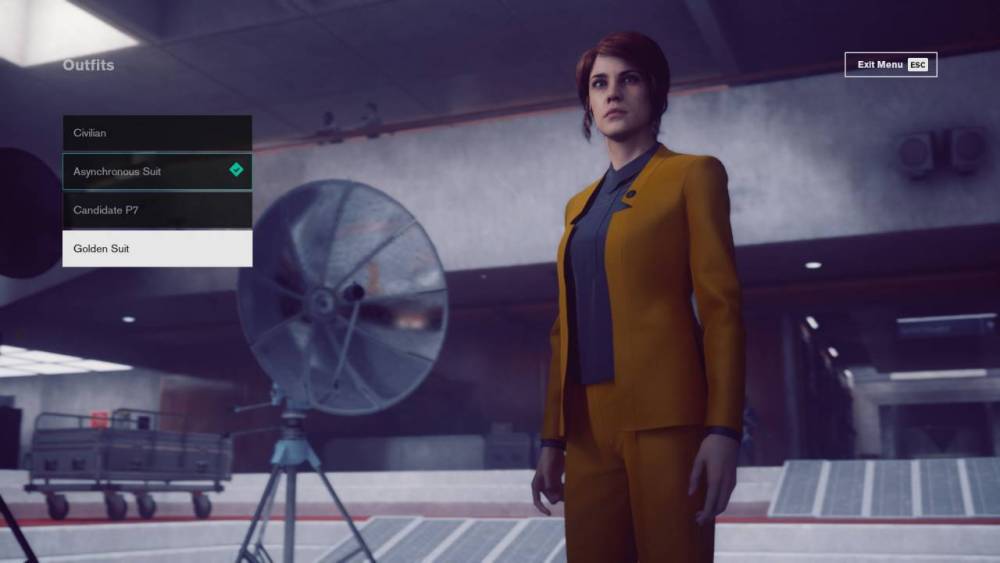
Making my girl look fantastic!
The Control Ultimate Edition Story: A Detailed Narrative/World That I Couldn’t Engage With
I’d say a good way to succinctly describe this is if you combined X-Files, the Twilight Zone, Stranger Things, and the Umbrella Academy into one big pot. All of these shows have a sci-fi backdrop, have shocked the audience with twists, and with a good dose of some behind-the-scenes presence looking to destabilize the world.
Control absolutely draws from this. Many of the plot details cannot be shared due to spoiler potential, so you’ll have to forgive me as I try to give you the clearest picture of a storyline.
The protagonist is Jesse Faden, who enters the Federal Bureau of Control, an allegedly fictional government agency focusing on researching, stabilizing, and curating all things paranormal during a suspicious lockdown. The agency is set up in an ever-shifting base called the Oldest House, which operates as a connection between multiple dimensions.
Jesse is on a hunt to find her brother, Dylan, who was taken by the FBC when they were both children, following a paranormal event in their hometown that left them as pretty much the only survivors.
Jesse finds the former Director dead in his office and acquires his gun, which is something called an object of power. Ranging from a Japanese kite to a refrigerator to a television set, these seemingly mundane objects of power are all extremely dangerous in their ability to warp reality.
These objects are normally harmful to the average person, but Jesse is able to bond with the service weapon and assumes the role of Director. This is one of the weirder succession plans I’ve ever come across, but if it works, it works.
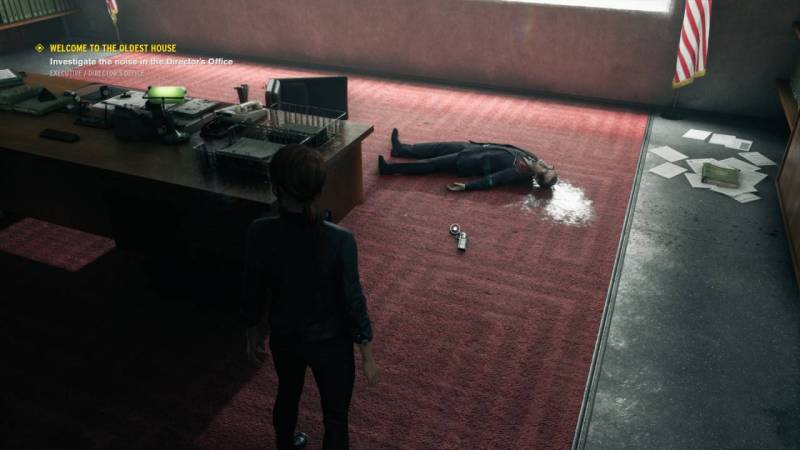
If Jesse were a minority, this would have been game over right here
Jesse skips Day One orientation and gets thrown straight into a crisis. A malevolent entity named the Hiss has infiltrated and corrupted a large portion of the facility, leaving it a nightmare to navigate. Mutated former colleagues are completely corrupted and pop in from the ether to celebrate your promotion by shooting at you.
Much of the story involves dealing with the various situations that are rapidly spinning out of control and restoring them to a relative state of order. The game deliberately clouds much of the explanatory information at the beginning, but just like any mystery, your actions and inquiries slowly illuminate the darkness.
As Jesse, you run around the Oldest House doing missions for various staff members you rescue. Some involve clearing out Hiss infestations, others involve corralling rogue paranormal objects, and some are more akin to your basic fetch-quest, where you have to find certain objects to interact within a specific area.
Meanwhile, a collective called The Board speaks to Jesse from the Astral Plane and gives her guidance on how to perform her role as Director. Joining this agora in her head is another voice, named Polaris, that the player cannot hear but helps Jesse along the way.
In addition to the main story, Control Ultimate Edition comes with extra downloadable content (DLC), allowing Jesse to explore other areas of the Oldest House and learn a few more secrets about life in the Bureau. They clearly are teeing this up for a sequel, which has been announced with no timing specifics.
There are a lot of good things going on here, but why couldn’t I engage with the game? Well, for one, you could say personal preference.
I fully understand that this paranatural agency genre is very well-received historically, but it really isn’t my cup of tea. I like sci-fi, but my interests lie in superpowers or robots or outer space instead of dimensional hijinks.
That purely subjective note aside, I’m not going to lie that perhaps due to my inexperience with this genre, I spent a large part of Control Ultimate Edition not knowing what the hell was going on.
I’d describe the way the plot was presented as very outside in, where if you imagine a narrative flow being a line, most of the plot events moved you along the line by circling around it and painting the picture along the peripheries. Basically, not much is said outright.
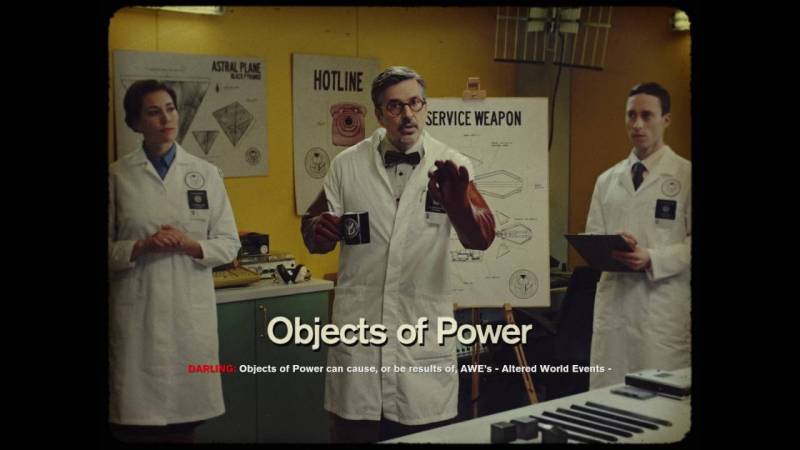
It is important to always wear protection.
In a few instances, Jesse will clarify things, but most of the time, you’ll have to piece together snippets of dialogue that seem to be almost convoluted by design. The game is a little cut-scene-heavy, but I didn’t get the impression that these were placed willy-nilly just to add them.
What I did find delightful was how they used real-life actors juxtaposed amidst a rendered character’s world to illustrate certain concepts. A key example is the former head of research, Casper Darling, appearing in a series of educational videos around the facility (see above).
The objects driving the plot forward that I had the most trouble with were the various collectibles strewn around the Oldest House. These could be anything from recordings of speeches by former Bureau executives to documents detailing paranormal events to case files on specific story objectives/enemies.
As with everything involving the narrative in Control, these were half useful information, half twaddle, so I eventually just gave up reading them. It’s a shame because I can tell that a lot of love was put into crafting this experience; I just didn’t care after a certain point to listen to another speech from the previous Director that didn’t really tell me much.
One thing I have to applaud, however, is the world design. This is the thing that kept pulling me forward: seeing more of the Oldest House and its various secrets.
Despite all the frills of living in various planes of existence and being overrun by an extra-dimensional lice infestation, the facility is still very much run by the US government. Boy, does it look like every large federal building I’ve ever been in. Fresh marble, glass everywhere, everything uniform; you could feel the bureaucracy that existed here under normal circumstances.
What’s more, the developers did an excellent job of making the ambiance creepy and supernatural without being too heavy-handed. There were multiple instances in the game where even if Jesse was a telekinetic demigod, I still felt my neck prickle with apprehension due to the lighting and ambient sound.
The Hiss can also drop in on you at any time, so almost NOWHERE is safe. For a game with no jump scares to make me occasionally feel on edge, that’s really quite well done.
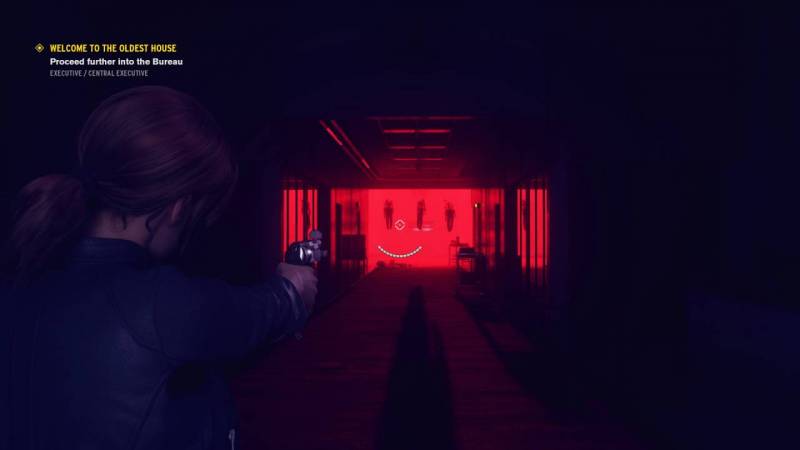
Rule of the road: if you see red, it’s bad news
As you unlock more powers and abilities, previously unexplored areas of the map become available. These areas can unlock new missions, provide you with resources, and somehow most valuably, give access to shortcuts.
For example, a level 6 security door that would be locked because you haven’t found the right key card will suddenly be accessible after finding said card, and this could give you access to a new mission to unlock a superpower. Fast travel points are likewise scattered around the map at strategic areas. After clearing the area of enemies, you can freely use them to teleport, upgrade your weapons, or trade in bounties for resources.
On the flip side, the player’s minimap is easily one of the worst I’ve ever had the misfortune of interacting with. I don’t know if that was the point or if they genuinely thought that expressing it in this way was a good idea, but it was basically useless, and I navigated off memory and reflex after a while. The twisting and winding corridors snake in all sorts of directions, and a map of this design doesn’t represent multiple floors that well.
Tip to you new players, read the signs on the walls. It’s a government building, so they kindly label departments quite clearly for the drones to find their way. It’s much easier to get around using those as opposed to looking at this filth.

I’ve seen dilapidated mall maps with more clarity.
In a final note about the narrative, the characters were decent. Most of them were nothing to write home about, as it’s hard for me to develop an interest in someone spouting drivel at me, but two stood out specifically: Emily Pope, a member of the research team who becomes your closest confidant, and Ahti, a mysterious janitor that is clearly more than he seems.
In different ways, these two, in particular, exuded charm, and I exhausted their dialogue trees whenever I could to hear what they had to say next. I’d recommend you do the same.
Control Ultimate Edition‘s Core Combat Gameplay: Satisfying Moments But Largely Unengaging
So we’ve established that the story and world have a lot going on and were clearly put together with passion (albeit not to my taste), but what can we say about the actual gameplay? By and large, I find that what you are asked to do is a little uninspiring. There were some really fun elements, to be sure; I, unfortunately, did not feel any of them hold my attention for longer than a few hours at a time.
The majority of the missions involve combat of some sort, so we will be devoting an entire section to it. As mentioned, Jesse uses the “Service Weapon,” and what makes this gun special — besides being able to select the head of a federal agency — is that it is able to shift forms for different situations. To name a few, Shatter functions like a shotgun, Pierce is a sniper rifle, and Charge is a rocket launcher.
You can upgrade their damage and increase the upgrade slots by utilizing resources found throughout the environments and from defeated enemies. Two forms are equipped at one time, but it’s important to know that guns use the same ammo pool. It’ll regenerate when depleted, but switching to a different mode will still leave your clip empty until you wait for the recharge bar to fill.
To reiterate, there is NO traditional ammunition in this game, so thankfully, you will not be running about looking for a resupply point.
Before you get too excited, the gunplay in this game is extremely underwhelming. Even upgraded, these weapons don’t feel like they do that much to really turn the tide against anything but the weakest of enemies. I mostly stuck with the default Grip function (a heavy-hand pistol), which was the most useful of the bunch. The others traded off too much to be entirely useful in 90% of situations.
For example, Pierce may do a lot of damage, but it has two ammo slots and takes a while to charge up a shot. Not the best for a prolonged firefight. Charge, being an explosive launcher, does a decent amount of damage but it’s hard to aim properly, and catching yourself in a blast has a high chance of killing Jesse. Not the best for a short-range firefight. You get the idea.
Grip provided the most balance in terms of fire rate, damage, precision, and ammo clip. The Hiss spend a lot of time either in mid-range shooting you or in close range swarming you, so being able to deal with both on the fly was essential.
Speaking of precision, when I say that, what I really mean is “aim at that enemy and hope that something hits them” because when not aiming down the sights, the spread seemed really loose. However, on the flip side, aiming down the sights made things even worse.
In the midst of an intense firefight where you are fighting interdimensional entities that can spawn anywhere, having mobility and situational awareness is essential. The game makes a point that you need to keep sprinting around to avoid getting shot. So to increase your precision to, you know, actually hit what you’re aiming at, you are better off using the sights.
The problem is that aiming down the sight slows you down and, more obnoxiously, puts the camera right behind Jesse’s shoulder. It’s actually such a goofy angle that her torso occupies a good 40% of your screen. We’ve seen this in other games for sure, but enemies in this world can defy the laws of physics by flying, teleporting, or turning invisible.
As you might imagine, not being able to see to the left or right depending on the angle means that a bushwhacking is always on the menu. What’s even more hilarious is that I found the precision increase to be very minimal, making it hard to justify using it a lot of the time.
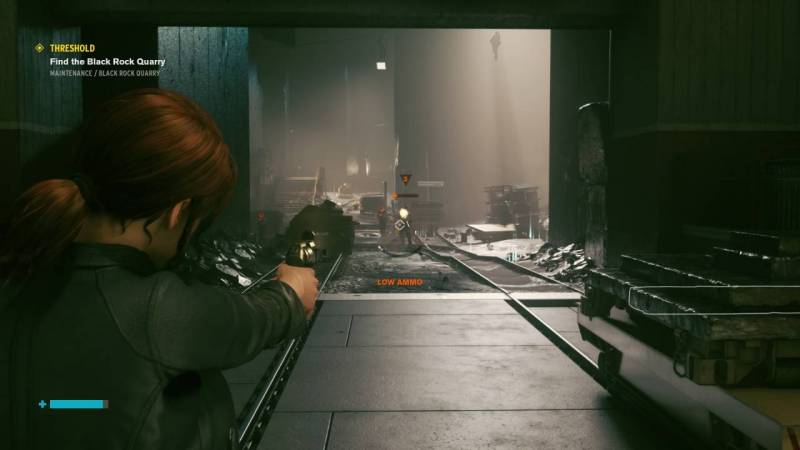
Jesses’ hair looks great, but we’re kind of busy at the moment
Thankfully, by interacting with paranatural objects around the house, Jesse can bind them to herself and gain supernatural abilities. For example, a floppy disc allows her to telekinetically launch objects, whereas a safe allows her to assemble a shield of debris around herself.
I’m going to come out and say that the Launch ability 100% saved this game for me.
Being able to pick up pieces of the environment and absolutely yeet them at a demon’s face was the best part of the Control experience. No doubt in my mind about that. The way these things rocket around and destroy the room you’re fighting in may not be the most realistic, but god damn if it isn’t enjoyable.
In fact, I would go so far as to say that because of its attack power, versatility, and sheer fun factor, Launch is the only ability you will use in the vast majority of combat situations.
Upgrading this in your skill tree should be priority number 1, 2, and 3. It became so superior that the aforementioned gun (which has an ENTIRE upgrade system and resource economy designed around it) became something I used to kill time while my magic pool recharged.
Yes, just about the only thing you’ll be killing consistently is your time when you use this gun.
Another ability that resuscitated my dwindling will to see this story through was the ability to levitate. You can unlock it around 30%-40% of the way through the game, and all I can say is that I wish they had given it to you in the second mission. It quite simply opens up so many options in terms of traversal and eliminating Hiss soldiers.
Controlling Jesse while she is on foot is such a clunky experience that the contrast is almost blinding. She’s slow, takes corners like Donkey Kong in Mario Kart, and is quite frankly always at a disadvantage.
The game eventually gives you the ability to dash a short distance in any direction, but unfortunately, that consumes your magic stamina, and you’ll be vulnerable sooner rather than later while it recharges. Levitation costs nothing, so your magic is better spent getting to a higher elevation and sending every available piece of the Ikea catalog careening into someone’s face.

“Let’s Make Your Home Special”
In terms of enemy composition, I think they did a decent job in a vacuum. All your foes are corrupted by the Hiss, and while some are reskinned dudes with guns, others have mutated into truly mesmerizing and horrifying forms.
In general, however, all of them except for the basic security officers can be lethal if you aren’t ready for them. The ones that struck me as the most unique were called the Hiss Distorted. These folks are bad news all around because they exist in an invisible state until they get close to you. You can still attack them while they are invisible but good luck finding them with any consistency.
Being stuck in a room with one or two of these was the experience most akin to horror, and the way the sound design of their muted quiet approach, only to be followed by a blast of audio as they flicker back to reality, definitely caught me off guard. If you want to feel like you’re getting hunted by a predator, that’s the enemy for you.
Another thing I especially enjoyed besides throwing office furniture at my problems was the various zany missions that popped up every now and again. These were pretty awesome and were welcome changes of pace from the relatively one-dimensional combat.
These are often in the form of puzzles, and I distinctly recall a mission where you are tasked with finding the unlock sequence to get into a containment cell holding a mirror. The mirror is locked in a vault, and you have to figure out how to align the specific pads around its cell to release the door. Not to give anything away, but the only clue you get is “looking in the mirror shows you what it wants.” There’s truly an incredible level of design; I loved it.
While none of these puzzles are insanely complex, you are still forced to think through it on your own with minimal advice from the game itself. This is where the convoluted and nebulous storytelling really shined because it made you put the pieces together to achieve some forward progression — providing more “agency” for the player if you will (pun intended).
I would have loved for there to be more missions like this, and I think it would have made for a much better overall experience. Off the top of my head, there were only a handful of specific situations that required you to use your brain or try something new. I’ll discuss this more in the next section as well.
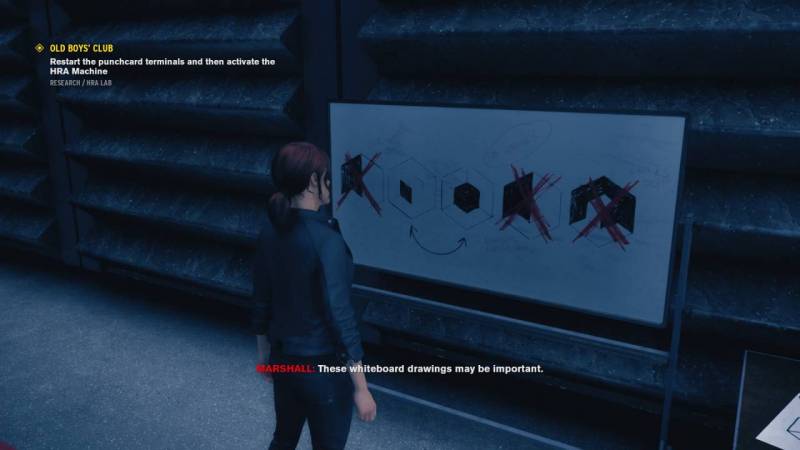
Just about the only hint that you’ll get in these situations
The Overall Vibe: A lot of Intricate Details That Don’t Matter
So this last category I’m judging this on is a little confusing, but I’ll do my best to make this simple. Control undoubtedly throws a lot of information and gameplay elements out there for the player to fiddle with, but ultimately 90% of it doesn’t make any difference whatsoever. When a game has that many bells and whistles that you can ignore safely with relatively minimal consequence, that strikes me as suboptimal design.
For example, let’s talk about the gun again.
As mentioned, there is an entire economy designed around improving this weapon. The resources you collect can upgrade and unlock the various forms of the weapon while also being used to create mods that can be equipped to the gun — or Jesse herself — that modify stats.
Examples include increasing damage output for your weapon and increasing health restored per health pickup for Jesse. There are quite a few options to choose from, but I ultimately felt it didn’t matter. They were so inconsequential that I just slotted in whichever ones were the max level and never touched it again.
This, coupled with the already underwhelming performance of the gun — even with max damage mods equipped — meant that you would ignore fiddling with this system a vast majority of the time.
Likewise, with the abilities, you see a similar phenomenon. The only ability truly worth a damn is Launch. That’s it, game over; thanks for coming.
There are certain enemies designed to counter-launch by reactively dodging projectiles, but you can get around that by shooting them once or twice to distract them before sending a desk their way— or you can just get really close and then launch. Odds are they won’t be able to move out of the way fast enough. A slight change in tactics, to be sure, but that’s one enemy type out of 11.
I will stress again that I think the enemy design was interesting, but when most problems can be solved with just one simple trick, you won’t be able to enjoy the enemy variations as they all end up as dust too quickly.
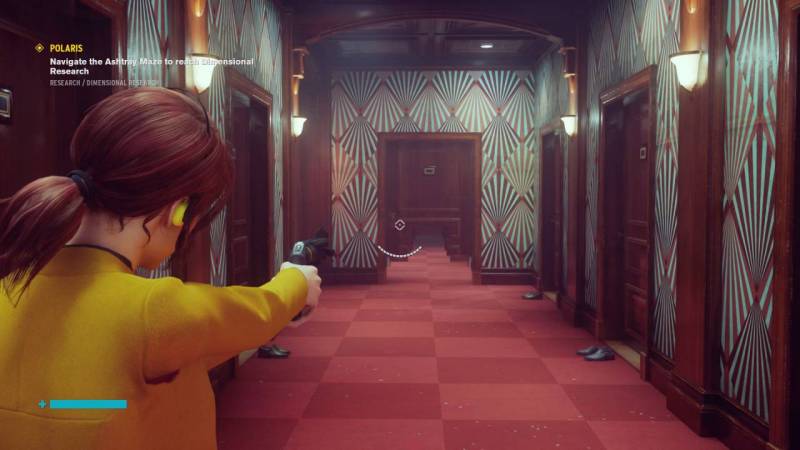
Ashtray Maze
These elements, combined with an obfuscated yet pretty linear plotline told through jargon, create an illusion of complexity, where once you find what you need, everything else is just useless fluff that can be ignored.
On a slight tangent, the most striking missed opportunity for me was that this game had so much potential to really get whacky with mission design. I totally understand that combat is an essential component and would get boring without blasting enemies away, but why did most missions have to boil down to “go here, shoot them, go somewhere else”?
You’re set in a house that exists across multiple planes, and literally ANYTHING could happen. I would have loved to see the developers build this creativity into more missions.
Don’t get me wrong; there were a few that embraced this concept. The best missions in the game, hands down, were those that threw you into trippy situations while dealing with enemies at the same time.
A level called the Ashtray Maze is a perfect example. Jesse is forced to run through an ever-shifting maze, finding her way through enemy patrols to the exit, all the while with a song blaring aptly named “Take Control.”
It sounds really simple but what could have been a straightforward shoot-them-up mission threw a little twist in it that made it one of the best in the game. In one of the DLC, they even give you the ability to replay it later at your leisure, so they 100% know what appeals in this setting.
Another example is the mission of Jesse Starring Faden Starring in “Swift Platform.” In this one, you’re traveling on two parallel platforms at very high speed, chasing a film camera object of power. You have to dodge the obstacles, shoot at the bad guys, and remain on either platform at all times.
It’s almost like 3 dimensional Frogger mixed with Space Invaders. With a retro synth-wave song playing in the background, chill ambient nightclub lighting, and Jesse throwing pieces of rebar at flying dudes, it was great.
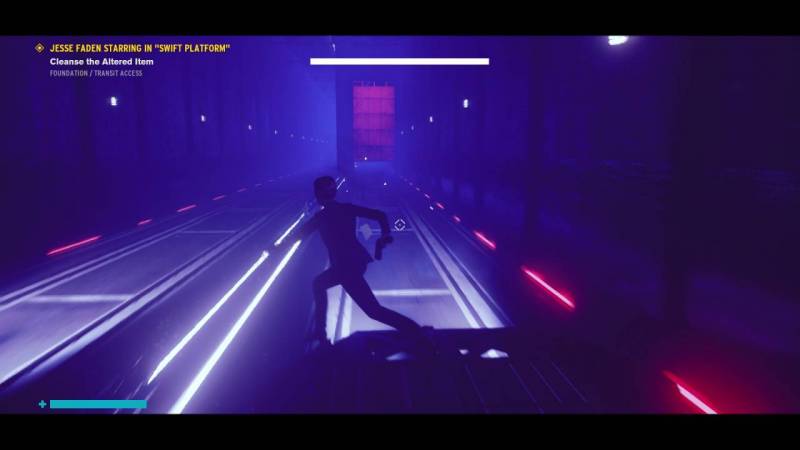
Do you see that door? Move out of the way.
I know this isn’t an expository paper, but I’m going to be cute and give three examples anyway. The entire second DLC (AWE) involves tracking down a boss that is invulnerable except when exposed to light.
Of course, the Hiss are there trying their best to steal your Cheerios, but eliminating them becomes secondary to finding a way to get away from the oppressing darkness. This boss can appear ANYWHERE there isn’t light and will kill you in almost a singular hit, so it turned every combat encounter into a puzzle of sorts. Figuring out how to unlock power nodes and find batteries for these nodes to increase your area of relative safety was a really fun challenge.
My point is the game does best when things are just slightly ridiculous, and I felt that it could’ve been that much better if it embraced this even further instead of cramming in a bunch of stuff that made no difference.
Final Thoughts
I beat the game but didn’t complete every mission of the third DLC. If I’m truly enjoying something, I will do almost every piece of content I can reasonably access, so that’s telling in terms of my assessment. I really could not get behind some of the design choices or how the story was told, but here’s the thing; I’m going to give this game a slightly higher score than I think it deserves.
My experience was a solid 3/5 (which isn’t bad!), but I’m going to give it 3.5/5. This is simply due to the fact that I KNOW Control Ultimate Edition will scratch an itch for enough people out there that their experience will be anywhere from 4-4.5 out of 5. Let’s just split the difference, shall we?
It all honestly, Control has its moments, and if you’re a fan of the Twilight Zone type of genre and/or enjoy playing as a protagonist doing their best imitation of a rail gun, this may just be a home run for you.
I’ll leave it at this, I plan to play the sequel when it releases, so this game clearly resonated with me on a certain level, even if I didn’t fall in love with it.
Control Ultimate Edition sells for $39.99; it is available from Steam, Epic, Xbox, Playstation, and others.
Source: Personal Purchase
Developer/Publisher: Remedy Entertainment/505 Games
What I Like: Great world ambiance and design; Telekinetic Launch Ability/Levitate are really fun: Some missions were truly stellar in terms of design
What Needs Improvement: A lot of progression elements are meaningless; The majority of missions should have steered towards the bizarre a little more; Figuring out the story bored me after a while
